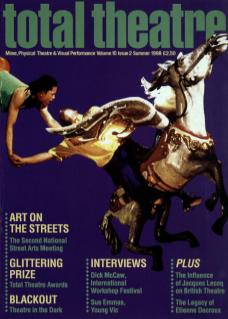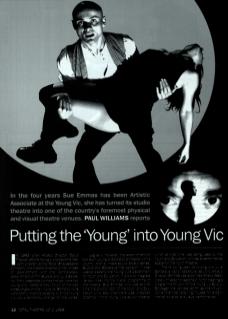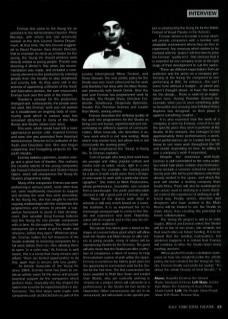In 1993 when Director David Thacker left the Young Vic to become resident director at the Royal Shakespeare Company, the theatre entered a new phase of development with the controversial appointment of Tim Supple and Julia Bardsey. Many observers claimed the pair were too young and inexperienced. Much of the bad press verged on the vindictive. Some pundits were fearful that the personality of the Young Vic would somehow change for the worse.
Logically, however, the appointment of two such young directors to a theatre with a youthful profile, made artistic sense. Supple and Bardsley’s first decision in post was to disband the Young Vic’s department for Youth and Education, in a bid to integrate its activities into the overall programme of the theatre. Sue Emmas, who was at that time the Co-ordinator of the Youth and Education Unit, saw that there was untapped potential in the Young Vic’s studio theatre, which at that time was being used by the Youth and Education Unit as a performance space for Youth Theatre. The following year, coinciding with Julia Bardsley’s rapid departure as joint Artistic Director, Emmas was appointed Artistic Associate with specific responsibility for creating a programme of work for the Young Vic Studio. So began the venue’s rebirth as one of London’s foremost receiving houses for experimental physical and visual performances.
Emmas first came to the Young Vic as assistant to the Administrative Director, Philip Bernays, with whom she had previously worked at the Arts Council Drama Department. At that time, the Arts Council suggested to David Thacker, then Artistic Director, that to maintain its remit as a theatre for the young, the Young Vic should produce work directly related to young people. Thacker was directing A Winter's Tale when the recommendation was made, and included a community element to the production by enlisting people from the locality to play shepherds and country folk. As they were still in the process of appointing a Director of the Youth and Education section, the ever resourceful Emmas took over the work in the interim.
Thacker's concept for the production changed and, subsequently, the people were not used. But Emmas' work was not wasted as it established an ongoing body of community work which in various ways has remained attached to many of the Main House and Studio shows ever since.
This work, which would have left a more egomaniacal person cold, inspired Emmas and soon she was promoted from Assistant Administrative Director to Co-ordinator of the Youth and Education Unit. She also began supporting and instigating projects for the youth theatre.
Emmas radiates optimism, creative energy and a great love of theatre. She nurtures the creative talents of the young companies, like Forced Entertainment and Station House Opera, which still characterise the Young Vic Studio's programme today.
Many of the companies Emmas saw were performing in venues which, more often than not, were insufficiently resourced to support and develop the work they were promoting. At the Young Vic, she has sought to nurture ongoing relationships with the companies she programmes and strives to provide a supportive framework to assist in their development. One valuable thing Emmas believes that the Young Vic can provide companies with, is time. As she explains, ‘the ideal is that companies get a week to get-in, make and rehearse, before they open’. Wherever possible, Emmas makes the full resources of the Studio available to incoming companies for a full week before their run, thus allowing them to open in a calm way. As Emmas is well aware, this is a luxury that many venues can't afford: ‘there are limited opportunities to do this, apart from in venues with less profile’.
As Artistic Associate of the Young Vic since 1994, Emmas' remit has been to create an artistic vision for the venue and provide practical support for the companies which perform there. Gradually she has shaped the space into a centre for experimentation in performance. The first steps were made with companies such as Da Da Dum as part of the London International Mime Festival, and Trevor Stewart. The new artistic policy for the Studio was very much influenced by the work Julia Bardsley had done with the Main House, and previously with Derek Derek. Over the past year Emmas has programmed work by Hoipolloi, The People Show, Christine Entwhistle, Strathcona, Desperate Optimists, Theatre Pur, Primitive Science and Louder than Words, among others.
Emmas describes the defining quality of the work she programmes for the Studio as being non-text based, experimental and concentrating on different aspects of communication. More basically, she describes it as, ‘new work which is not new writing. Work which may involve text, but where text is not necessarily the starting point.’
It also emphasises the 'Young' in Young Vic. As Emmas explains: ‘Lots of people who bring their work here are younger and utilise popular culture and media such as video, music, light in a very vibrant way. For example, the starting point for a piece of work could come from a designer who wants to work with a particular choreographer.’ She refers to Wink Productions, whose performance, Soundbite, was created from a soundscape. The youth and education element is still a great part of Emmas' vision.
‘Much of the drama work done in schools is still very much based on a narrative tradition. It is so important for us to encourage young people to come to the Studio and experience new work. Hopefully, some will be inspired and in this way we create a future audience.’
This desire has been given a boost in the shape of a recent lottery grant which will allow both the Studio and Main House to offer tickets to young people, many of whom will be experiencing theatre for the first time. The grant will also mean that the Studio can offer a selection of companies a block of money to help them produce a piece of work within the space. Emmas is excited as the lottery grant gives her the opportunity to commission work for the Studio for the first time. The first commission has been awarded to Ruth Ben Tovim and Louder than Words, who are currently working in schools on a project which will culminate in a performance in the Studio for two weeks in November. Other commissions are yet to be announced, but will include a site-specific project co-produced by the Young Vic for the British Festival of Visual Theatre in the Autumn.
Emmas’ dream is to create a venue which will provide companies with a familiar and adaptable environment where they are free to experiment. Any company which wishes to be involved with the project will first have to pass the ‘Emmas quality test'. She stresses that it is essential for any company to be at the right stage of their development to suit the space.
‘There are different expectations from an audience and the press on a company performing at the Young Vic compared to one performing at BAC, for instance... You can't come here without a budget... or where you haven't thought about, or don’t have the money for, the design... There is more of an expectation here. Having Primitive Science for example: when you've seen something quite so beautiful and amazing which Robert Innes Hopkins has designed, to then place it against something rougher...’
It is also essential that the work of a company is seen by Emmas, even if it is not the specific piece they wish to perform at the Studio. At the moment, she manages to see approximately three performances a week. Most performances are in London but she is trying to see more work throughout the UK and would, depending on time, be willing to see a company's work if requested.
Despite her enormous workload, Emmas is still committed to the extra activities which take place outside of performance. These include a summer school for seven to twenty year-olds led by practitioners who have already worked in the space, and which this year will involve a visiting company from South Africa. There will also be workshops to give actors used to working in a more classical context the experience of working in a different way. Finally, actors, directors and designers who have worked in the Main House will be invited to use the Studio to share ideas, thus creating the potential for future collaborations.
The Young Vic project is still in its early stages. When I ask Emmas where the Studio will be in five or ten years, she reminds me that much relies on future funding. It is to be hoped that the funding materialises, but whatever happens it is certain that Emmas will continue to drive the Studio down many exciting avenues.
When pushed to make a definitive statement on how she would describe the artistic policy she has created for the Young Vic Studio, Emmas finally succumbs by saying: ‘It's about the whole beauty of total theatre.’


